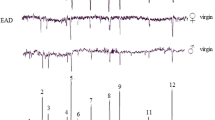Abstract
Grapevine moth Lobesia botrana is the economically most important insect of grapevine Vitis vinifera in Europe. Flower buds, flowers, and green berries of Chardonnay grapevine are known to attract L. botrana for oviposition. The volatile compounds collected from these phenological stages were studied by gas chromatography—mass spectrometry, and the antennal response of L. botrana females to these headspace collections was recorded by gas chromatography—electroantennography. The compounds found in all phenological stages, which consistently elicited a strong antennal response, were pentadecane, nonanal, and α -farnesene. In a wind tunnel, gravid L. botrana females flew upwind to green grapes, as well as to headspace collections from these berries released by a piezoelectric sprayer release device. However, no females landed at the source of headspace volatiles, possibly due to inappropriate concentrations or biased ratios of compounds in the headspace extracts.
Similar content being viewed by others
References
Arn, H. and Louis, F. 1996. Mating disruption in European vineyards, pp. 377–382, R. T. Cardé, A. K. minks (eds.). Pheromone Research—New Directions. Chapman and Hall, New York.
Arn, H., Rauscher, S., Buser, H.-R., and Guerin, P. M. 1986. Sex pheromone of Eupoecilia ambiguella female: analysis and male response to ternary blend. J. Chem. Ecol. 12:1417–1429.
Arn, H., Rauscher, S., Guerin, P., and Buser, H.-R. 1988. Sex pheromone blends of three tortricid pests in European vineyards. Agric. Ecosyst. Env. 21:111–117.
Arn, H., Städler, E., and Rauscher, S. 1975. The electroantennographic detector—a selective and sensitive tool in the gas chromatographic analysis of insect pheromones. Z. Naturforsch. 30c:722–725.
Bengtsson, M., Bäckman, A.-C., Liblikas, I., Ramirez, M. I., Borg-Karlson, A.-K., Ansebo, L., Anderson, P., Löfqvist, J., and Witzgall, P. 2001. Plant odor analysis of apple: antennal response of codling moth females to apple volatiles during phenological development. J. Agric. Food Chem. 49:3736–3741.
Bovey, P. 1966. Super-famille des Tortricoidea, pp. 456–893, A. S. Balachowsky (ed.). Entomologie Appliquée à l’Agriculture. Masson, Paris.
Buchbauer, G., Jirovetz, L., Wasicky, M., and Nikiforov, A. 1994. Headspace analysis of Vitis vinifera (Vitaceae) flowers. J. Essential Oil Res. 6:307–309.
Buchbauer, G., Jirovetz, L., Wasicky, M., and Nikiforov, A. 1995. Aroma von Rotweinblüten: Korrelation sensorischer Daten mit Headspace-Inhaltsstoffen. Z. Lebensm. Unters. Forsch. 200:443–446.
Darriet, P., Pons, M., Henry, R., Dumont, O., Findeling, V., Cartolaro, P., Calonnec, A., and Dubourdieu, D. 2002. Impact odorants contributing to the fungus type aroma from grape berries contaminated by powdery mildew (Uncinula necator); incidence of enzymatic activities of the yeast Saccharomyces cerevisiae. J. Agric. Food Chem. 50:3277–3282.
El-Sayed, A., Gödde, J., Witzgall, P., and Arn, H. 1999. Characterisation of pheromone blend for grapevine moth, Lobesia botrana by using flight track recording. J. Chem. Ecol. 25:389–400.
Fermaud, M. and Le Menn, R. 1989. Association of Botrytis cinerea with grape berry moth larvae. Phytopathology 79:651–656.
Gabel, B. and Roehrich, R. 1995. Sensitivity of grapevine phenological stages to larvae of European grapevine moth, Lobesia botrana Den. & Schiff. (Lep., Tortricidae). J. Appl. Entomol. 119:127–130.
Gödde, J., Arn, H., and El-Sayed, A. 1999. The pheromone sprayer: new technology in stimulus application. IOBC wprs Bulletin 22:49–56.
Hardy, P. J. 1970. Changes in volatiles of muscat grape during ripening. Phytochemistry 9:709–715.
Hashizume, K. and Samuta, T. 1997. Green odorants of grape cluster stem and their ability to cause a wine stemmy flavor. J. Agric. Food Chem. 45:1333–1337.
Klimetzek, D., Köhler, J., Krohn, S., and Francke, W. 1989. Das Pheromon-System des Waldreben-Borkenkäfers Xylocleptes bispinus Duft. (Col., Scolytidae). J. Appl. Ent. 107: 304–309.
Light, D. M., Knight, A. L., Henrick, C. A., Rajapaska, D., Lingren, B., Dickens, J. C., Reynolds, K. M., Buttery, R. G., Merrill, G., Roitman, J., and Campbell, B. C. 2001. A pear-derived kairomone with pheromonal potency that attracts male and female codling moth, Cydia pomonella (L.). Naturwissenschaften 88:333–338.
Louis, F. and Schirra, K.-J. 2001. Mating disruption of Lobesia botrana (Lepidoptera: Tortricidae) in vineyards with very high population densities. IOBC wprs Bulletin 24:75–79.
Mani, E., Riggenbach, W., and Mendik, M. 1978. Zucht des Apfelwicklers (Laspeyresia pomonella L.) auf künstlichem Nährboden, 1968–1978. Mitt. Schweiz. Entomol. Ges. 51:315–326.
Roelofs, W. L., Kochansky, J., Cardé, R. T., Arn, H., and Rauscher, S. 1973. Sex attractant of the grapevine moth, Lobesia botrana. Mitt. Schweiz. Entomol. Ges. 46:71–73.
Rosillo, L., Salinas, M. R., Garijo, J., and Alonso, G. L. 1999. Study of volatiles in grapes by dynamic headspace analysis. Application to the differentiation of some Vitis vinifera varieties. J. Chromatogr. 847:155–159.
Schreier, P., Drawert, F., and Junker, A. 1976. Identification of volatile constituents from grapes. $J$. Agric. Food Chem. 24:331–336.
Thiéry, D. and Gabel, B. 2000. Comportement de ponte des femelles de l’eudèmis de la vigne en présence d’extraits de fleurs de ‘Muller Thurgau.’ IOBC wprs Bulletin 23:135–138.
Varner, M., Lucin, R., Mattedi, L., and Forno, F. 2001. Experience with mating disruption technique to control grape berry moth, Lobesia botrana, in Trentino. IOBC wprs Bulletin 24:81–88.
Welch, R. C., Johnston, J. C., and Hunter, L. K. 1982. Volatile constituents of the Muscadine grape (Vitis rotundifolia). J. Agric. Food Chem. 30:681–684.
Author information
Authors and Affiliations
Corresponding author
Rights and permissions
About this article
Cite this article
TASIN, M., ANFORA, G., IORIATTI, C. et al. ANTENNAL AND BEHAVIORAL RESPONSES OF GRAPEVINE MOTH Lobesia botrana FEMALES TO VOLATILES FROM GRAPEVINE. J Chem Ecol 31, 77–87 (2005). https://doi.org/10.1007/s10886-005-0975-3
Issue Date:
DOI: https://doi.org/10.1007/s10886-005-0975-3




